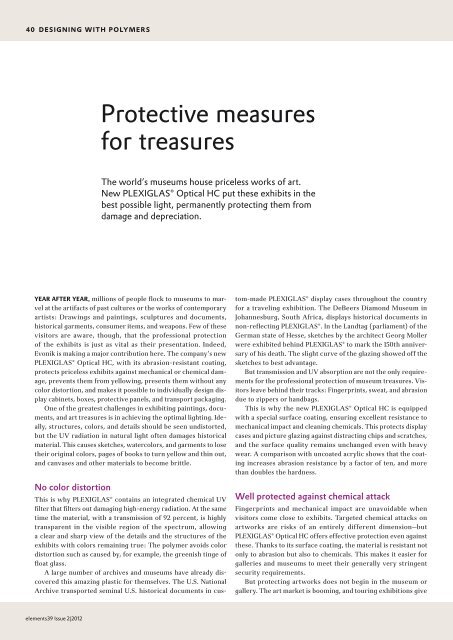Download - Evonik Industries
Download - Evonik Industries
Download - Evonik Industries
Create successful ePaper yourself
Turn your PDF publications into a flip-book with our unique Google optimized e-Paper software.
40 desIGnInG WItH PoLYMeRs<br />
elements39 Issue 2|2012<br />
The world’s museums house priceless works of art.<br />
New PLEXIGLAS® Optical HC put these exhibits in the<br />
best possible light, permanently protecting them from<br />
damage and depreciation.<br />
YeaR afteR YeaR, millions of people flock to museums to marvel<br />
at the artifacts of past cultures or the works of contemporary<br />
artists: Drawings and paintings, sculptures and documents,<br />
historical garments, consumer items, and weapons. Few of these<br />
visitors are aware, though, that the professional protection<br />
of the exhibits is just as vital as their presentation. Indeed,<br />
<strong>Evonik</strong> is making a major contribution here. The company’s new<br />
PLEXIGLAS® Optical HC, with its abrasion-resistant coating,<br />
protects priceless exhibits against mechanical or chemical damage,<br />
prevents them from yellowing, presents them without any<br />
color distortion, and makes it possible to individually design display<br />
cabinets, boxes, protective panels, and transport packaging.<br />
One of the greatest challenges in exhibiting paintings, documents,<br />
and art treasures is in achieving the optimal lighting. Ideally,<br />
structures, colors, and details should be seen undistorted,<br />
but the UV radiation in natural light often damages historical<br />
material. This causes sketches, watercolors, and garments to lose<br />
their original colors, pages of books to turn yellow and thin out,<br />
and canvases and other materials to become brittle.<br />
no color distortion<br />
Protective measures<br />
for treasures<br />
This is why PLEXIGLAS® contains an integrated chemical UV<br />
filter that filters out damaging high-energy radiation. At the same<br />
time the material, with a transmission of 92 percent, is highly<br />
transparent in the visible region of the spectrum, allowing<br />
a clear and sharp view of the details and the structures of the<br />
exhibits with colors remaining true: The polymer avoids color<br />
distortion such as caused by, for example, the greenish tinge of<br />
float glass.<br />
A large number of archives and museums have already discovered<br />
this amazing plastic for themselves. The U.S. National<br />
Archive transported seminal U.S. historical documents in cus-<br />
tom-made PLEXIGLAS® display cases throughout the country<br />
for a traveling exhibition. The DeBeers Diamond Museum in<br />
Johannesburg, South Africa, displays historical documents in<br />
non-reflecting PLEXIGLAS®. In the Landtag (parliament) of the<br />
German state of Hesse, sketches by the architect Georg Moller<br />
were exhibited behind PLEXIGLAS® to mark the 150th anniversary<br />
of his death. The slight curve of the glazing showed off the<br />
sketches to best advantage.<br />
But transmission and UV absorption are not the only requirements<br />
for the professional protection of museum treasures. Visitors<br />
leave behind their tracks: Fingerprints, sweat, and abrasion<br />
due to zippers or handbags.<br />
This is why the new PLEXIGLAS® Optical HC is equipped<br />
with a special surface coating, ensuring excellent resistance to<br />
mechanical impact and cleaning chemicals. This protects display<br />
cases and picture glazing against distracting chips and scratches,<br />
and the surface quality remains unchanged even with heavy<br />
wear. A comparison with uncoated acrylic shows that the coating<br />
increases abrasion resistance by a factor of ten, and more<br />
than doubles the hardness.<br />
well protected against chemical attack<br />
Fingerprints and mechanical impact are unavoidable when<br />
visitors come close to exhibits. Targeted chemical attacks on<br />
artworks are risks of an entirely different dimension—but<br />
PLEXIGLAS® Optical HC offers effective protection even against<br />
these. Thanks to its surface coating, the material is resistant not<br />
only to abrasion but also to chemicals. This makes it easier for<br />
galleries and museums to meet their generally very stringent<br />
security requirements.<br />
But protecting artworks does not begin in the museum or<br />
gallery. The art market is booming, and touring exhibitions give
















